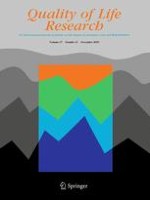26-07-2018
Physical, sensory, and cognitive functioning among centenarians: a comparison between the Tokyo and Georgia centenarian studies
Gepubliceerd in: Quality of Life Research | Uitgave 11/2018
Log in om toegang te krijgenAbstract
Purpose
The purpose of this study was to compare centenarians in the United States and Japan on sensory, cognitive, and physical functioning and to evaluate a model that tests the interrelationship between physical function, cognition, and sensory impairment in these two unique samples of the oldest old.
Methods
The sample of U. S. centenarians included 245 centenarians, the sample of Japanese centenarians included 304 centenarians. Sensory impairment was assessed by general assessments of vision and hearing, and physical function was assessed with six physical activities of daily living (i.e., eating, grooming, dressing, transporting, bathing, and walking).
Results
The results suggest that centenarians from the Georgia study showed higher levels of functioning in all domains when compared to the Tokyo sample. A structural equation model yielded stronger associations between cognitive and sensory function with physical function for the Tokyo sample.
Conclusions
Functional differences may be due, in part, to different care patterns for the oldest old in the United States when compared to Japan.
